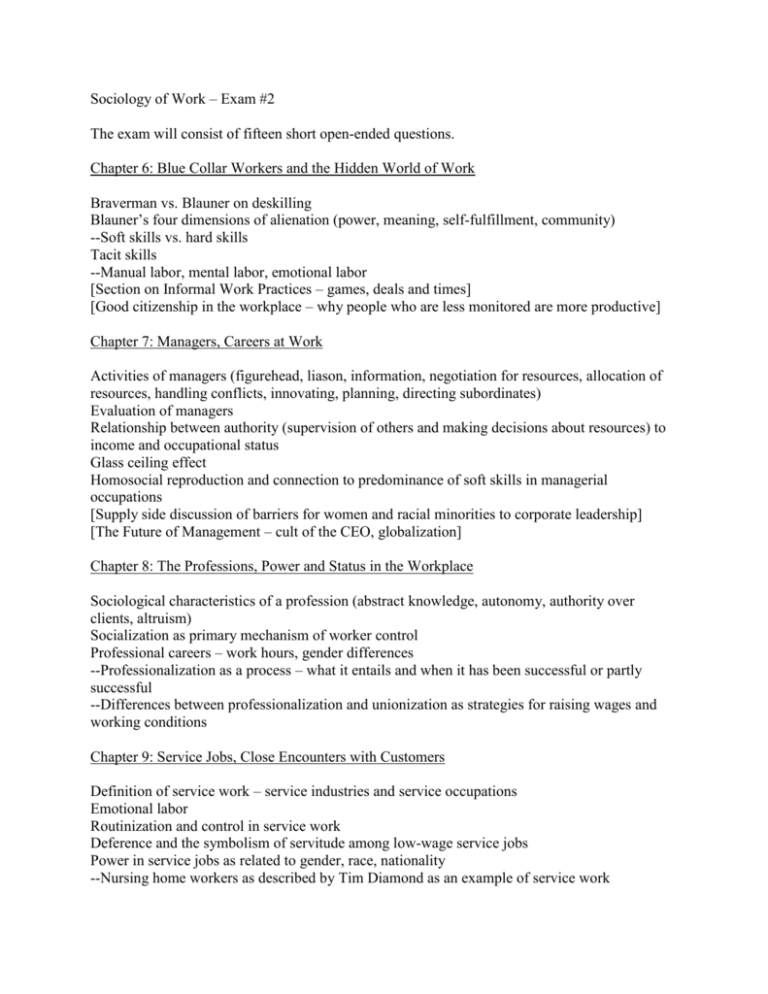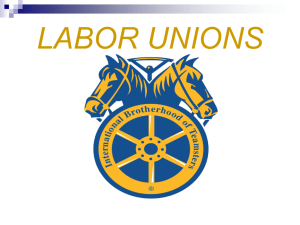Sociology of Work – Exam #2 The exam will consist of fifteen short
advertisement

Sociology of Work – Exam #2 The exam will consist of fifteen short open-ended questions. Chapter 6: Blue Collar Workers and the Hidden World of Work Braverman vs. Blauner on deskilling Blauner’s four dimensions of alienation (power, meaning, self-fulfillment, community) --Soft skills vs. hard skills Tacit skills --Manual labor, mental labor, emotional labor [Section on Informal Work Practices – games, deals and times] [Good citizenship in the workplace – why people who are less monitored are more productive] Chapter 7: Managers, Careers at Work Activities of managers (figurehead, liason, information, negotiation for resources, allocation of resources, handling conflicts, innovating, planning, directing subordinates) Evaluation of managers Relationship between authority (supervision of others and making decisions about resources) to income and occupational status Glass ceiling effect Homosocial reproduction and connection to predominance of soft skills in managerial occupations [Supply side discussion of barriers for women and racial minorities to corporate leadership] [The Future of Management – cult of the CEO, globalization] Chapter 8: The Professions, Power and Status in the Workplace Sociological characteristics of a profession (abstract knowledge, autonomy, authority over clients, altruism) Socialization as primary mechanism of worker control Professional careers – work hours, gender differences --Professionalization as a process – what it entails and when it has been successful or partly successful --Differences between professionalization and unionization as strategies for raising wages and working conditions Chapter 9: Service Jobs, Close Encounters with Customers Definition of service work – service industries and service occupations Emotional labor Routinization and control in service work Deference and the symbolism of servitude among low-wage service jobs Power in service jobs as related to gender, race, nationality --Nursing home workers as described by Tim Diamond as an example of service work --Arlie Hochschild’s The Managed Heart as an explanation of emotional labor and a study of flight attendants Chapter 10: Unions in America, The Struggles of the Labor Movement --Guest speaker Ethan Snow --Relationship of unions to democracy --Process of union formation and contract negotiation --Elements of a contract negotiated by the union [Wagner Act/National Labor Relations Act] [Impact of labor movement in first half of 20th century – wages and benefits of blue-collar workers created prosperous working class] [Decline of unions after WWII – Taft-Hartley Act of 1947 shifts Wagner Act provisions to give more power back to employers, management opposition to unions] [Impact of union decline on worker wages and voice] Chapter 11: Gender and Work Rise in women’s labor force participation Push factors pushing women out of the home – declining wages of men, divorce rates/perceived instability of marriage Pull factors pulling women into labor force – opportunities across occupations expanded during 1960s and 1970s, legal challenges to sex discrimination in education, women’s movement Sex segregation of jobs and occupations Reskin and Roos – shifts in occupational sex makeup – appropriateness as a social construction – most jobs contain both stereotypical male and stereotypical female elements – depends on emphasis and changes over time and with place Role of “protective” legislation for women limiting them to “appropriate” jobs and limiting hours or times of day – sometimes limiting to unmarried Explaining occupational sex segregation – supply side – worker preferences, values and abilities and demand side – opportunity structure Tokens – visibility, contrast and assimilation – glass escalator for men Gender wage gap --Lily Ledbetter talk/Lily Ledbetter Act (gender wage discrimination within occupation) --England article and class lecture on gender wage gap by occupational segregation --Theoretical explanations for the wage differential between female dominated and male dominated occupations: human capital, supervisory capacity, non-pecuniary benefits, valuative discrimination











